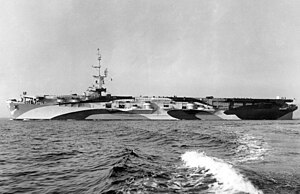 USS Commencement Bay in early 1945
| |
| History | |
|---|---|
| Name | Commencement Bay |
| Namesake | Commencement Bay |
| Builder | Todd Pacific Shipyards |
| Laid down | 23 September 1943 |
| Launched | 9 May 1944 |
| Commissioned | 27 November 1944 |
| Decommissioned | 30 November 1946 |
| Stricken | 1 April 1971 |
| Fate | Sold for scrap, 25 August 1972 |
| General characteristics | |
| Class and type | Commencement Bay-class escort carrier |
| Displacement | 21,397 long tons (21,740 t) |
| Length | 557 ft 1 in (169.80 m) loa |
| Beam | 75 ft (23 m) |
| Draft | 32 ft (9.8 m) |
| Installed power | |
| Propulsion |
|
| Speed | 19 knots (35 km/h; 22 mph) |
| Complement | 1,066 |
| Armament |
|
| Aircraft carried | 33 |
| Aviation facilities | 2 × aircraft catapults |
USS Commencement Bay (CVE-105) (ex-St. Joseph Bay), the lead ship of her class, was an escort carrier of the United States Navy. The Commencement Bay class were built during World War II, and were an improvement over the earlier Sangamon class, which were converted from oil tankers. They were capable of carrying an air group of 33 planes and were armed with an anti-aircraft battery of 5 in (127 mm), 40 mm (1.6 in), and 20 mm (0.8 in) guns. The ships were capable of a top speed of 19 knots (35 km/h; 22 mph), and due to their origin as tankers, had extensive fuel storage. Commencement Bay was employed as a training ship during the war, training new crews for the other members of her class as they were completed. She saw no active service after the war ended in 1945, instead being assigned to the Pacific Reserve Fleet, and was eventually sold for scrap in 1972.